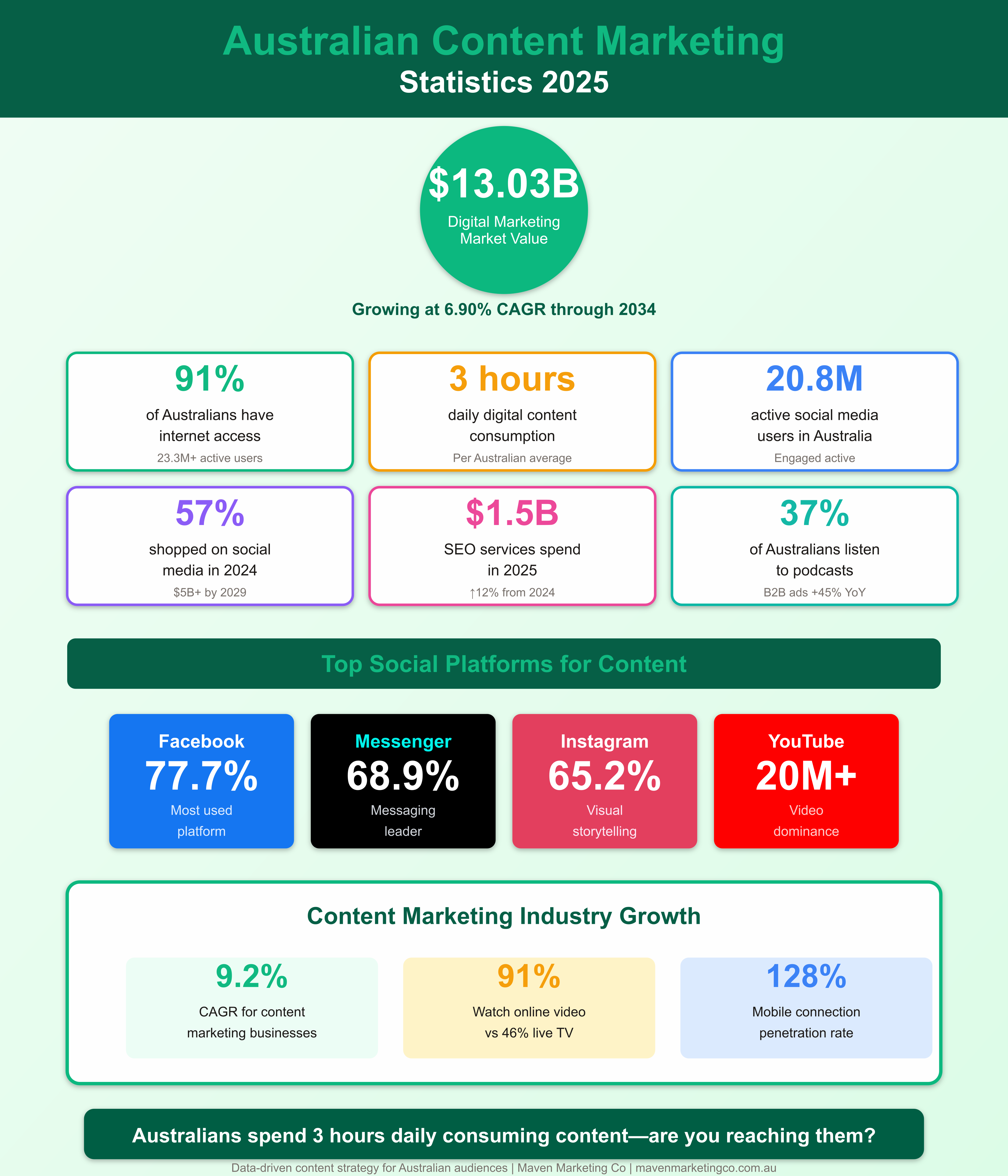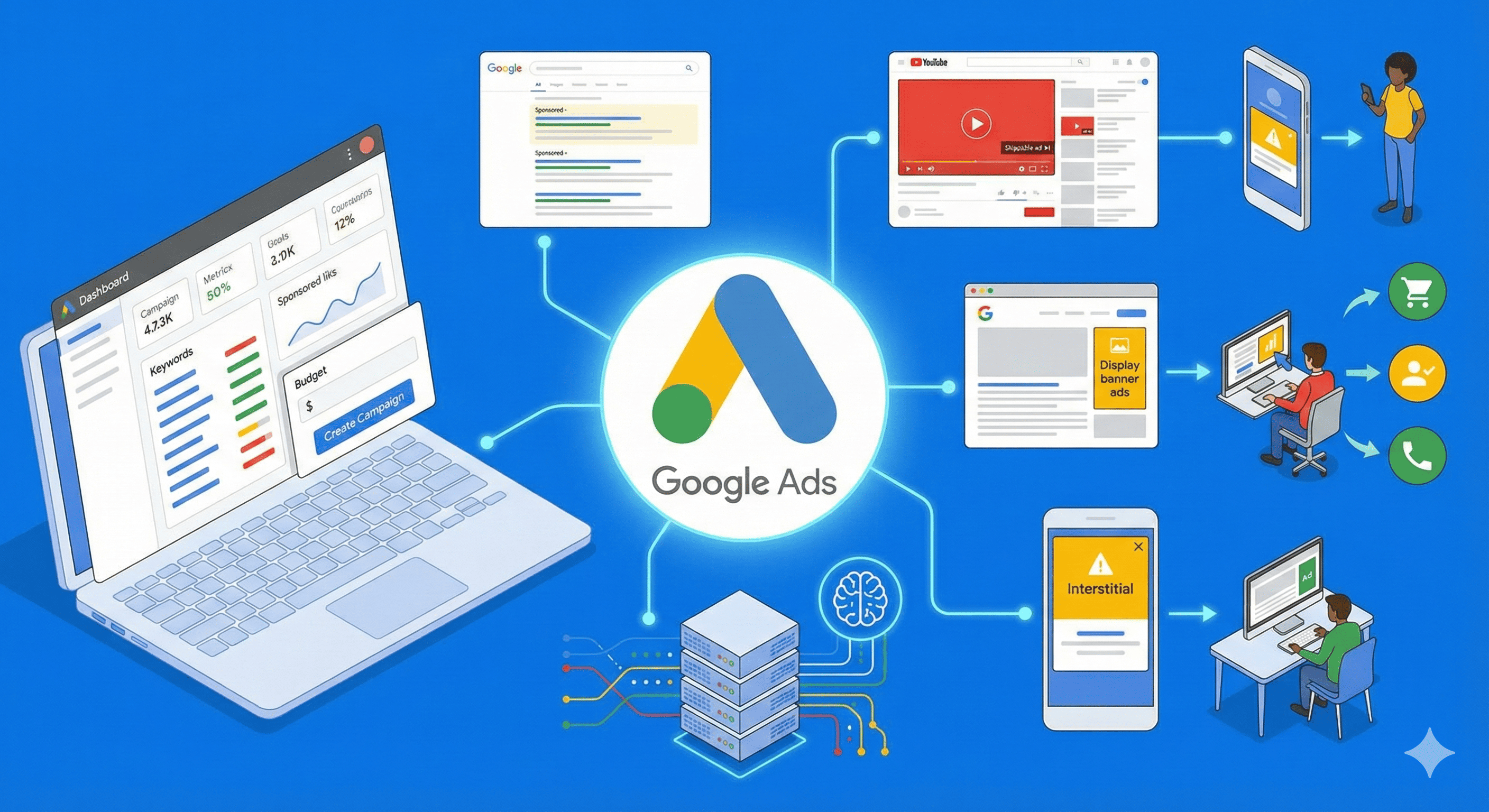
Australia's digital marketing landscape is worth $13.03 billion and growing at a remarkable 6.90% annually, yet many businesses still struggle to create content that truly connects with local audiences. The challenge isn't about producing more content—it's about producing the right content that reflects Australian values, addresses local concerns, and speaks in a voice that feels authentically home-grown rather than imported from overseas markets.
Creating a content marketing strategy that resonates with Australian audiences requires more than translating American or British campaigns with a few local references sprinkled in. It demands a genuine understanding of what makes Australian consumers tick, how they consume digital content, and what they expect from brands operating in this market. With Australians spending an average of three hours per day consuming digital content, brands have unprecedented opportunities to build meaningful connections—but only if they approach content creation with cultural intelligence and strategic precision.
Quick Answers: Australian Content Marketing Essentials
What makes Australian content marketing different?
Australian content marketing requires authentic cultural understanding beyond language adaptation. With 91% of Australians online and consuming three hours of digital content daily, successful strategies embrace Australian values of authenticity, straight talk, and self-deprecating humor while avoiding imported American approaches that feel inauthentic. Regional differences across cities and states require localized content strategies.
What content formats perform best in Australia?
Short-form video dominates Australian content consumption, with TikTok users spending 42 hours monthly on the platform. However, successful strategies incorporate multiple formats: video for engagement, written content for search visibility and depth, podcasts for the 37% of Australians who listen regularly, and interactive content for participation. Format selection should reflect audience behavior patterns.
How much should Australian businesses invest in content marketing?
Australian businesses typically allocate 20-30% of their marketing budget to content marketing, with the total digital marketing landscape worth $13.03 billion and growing 6.90% annually. Content marketing investment should align with strategic objectives, audience size, and competitive intensity, with consistent execution more important than budget size for building long-term results.
How long does content marketing take to show results?
Content marketing typically shows initial results within 3-6 months, with substantial impact emerging after 6-12 months of consistent execution. SEO-optimized content compounds value over time as search visibility improves and content libraries grow. Unlike paid advertising that stops when spending stops, content marketing builds sustainable assets that continue delivering value indefinitely.
Understanding the Australian Digital Consumer

The Australian digital consumer is sophisticated, discerning, and increasingly immune to generic marketing messages. As of early 2025, over 91% of Australia's population actively uses the internet, with 20.8 million Australians engaging with social media platforms regularly. These aren't passive viewers scrolling mindlessly—they're active participants who research extensively before making purchases, trust recommendations from peers over traditional advertising, and expect brands to understand their specific needs and contexts. According to We Are Social's Digital 2025 Australia Report, Australians spend an average of 5 hours and 35 minutes online daily, with social media accounting for 1 hour and 47 minutes of that time, demonstrating the critical importance of strategic digital content presence.
In 2024, 57% of Australians shopped on at least one social media site, demonstrating that the lines between content consumption, social engagement, and commerce have effectively dissolved. Today's Australian consumer expects seamless experiences that blend information, entertainment, and purchasing opportunities without feeling overly commercial or pushy.

What distinguishes Australian consumers from their international counterparts isn't just geography—it's mindset. Australians value authenticity over polish, substance over spin, and straight talk over corporate jargon. They're quick to call out brands that try too hard or come across as inauthentic. This cultural preference for genuine communication means content marketing strategies that work brilliantly in North American or European markets often fall flat when transplanted to Australia without adaptation.
The Australian sense of humour presents both opportunity and risk for content marketers. Self-deprecating wit, larrikinism, and irreverence are deeply embedded in Australian culture, but brands attempting to leverage these traits without genuine understanding risk appearing try-hard or offensive. The most successful content strategies embrace Australian cultural values naturally rather than forcing Australianisms into every piece of content.
The Current State of Content Marketing in Australia

In 2024, 91% of Australians used an online service to watch video content, whilst less than half (46%) watched live free-to-air TV, marking a fundamental shift in how Australians consume media and discover brands. This transition from traditional broadcast media to digital platforms has profound implications for content strategy. Brands can no longer rely on one-way broadcast messaging—they must create content that earns attention in an environment where consumers control what they watch, when they watch it, and how they engage with it.
The content marketing industry in Australia is experiencing robust growth, with businesses increasing at a CAGR of 9.2%. This expansion reflects recognition that traditional advertising alone no longer suffices. Modern consumers expect value from brand communications—whether that's education, entertainment, inspiration, or practical utility. Content that merely interrupts consumption without providing value gets ignored or actively avoided. The Content Marketing Institute consistently reports that businesses with documented content strategies are significantly more successful than those creating content reactively, highlighting the importance of systematic planning for Australian brands.
Short-form video has emerged as the dominant content format across Australia. TikTok users spend an average of 42 hours and 13 minutes per month on the platform, whilst Instagram Reels and YouTube Shorts command similarly impressive engagement levels. This preference for bite-sized video content doesn't mean long-form content has died—rather, it means brands must earn audience attention quickly and deliver value efficiently regardless of format.
The Australian podcast market now accounts for 37% of the Australian population, with B2B podcast advertising 45% higher than the previous year. This growth signals that whilst video dominates overall consumption, audio content fills specific needs for audiences consuming content whilst commuting, exercising, or multitasking. Smart content strategies incorporate multiple formats tailored to different consumption contexts rather than betting everything on a single format.

Core Principles for Australian Content Strategy
Successful content marketing in Australia rests on several foundational principles that must guide every piece of content you create, regardless of format, platform, or campaign objective.
Lead with Authenticity, Not Aspiration

Australian audiences possess finely tuned authenticity detectors. They can spot manufactured content, forced enthusiasm, and imported strategies a kilometre away. Content that feels genuine—even when imperfect—consistently outperforms slick, over-produced material that lacks soul. This doesn't mean amateur production quality is acceptable, but rather that polish should never come at the expense of authenticity.
Brands like Who Gives A Crap, Thankyou, and Canva have built enormous followings not through perfect content but through consistently authentic communication that reflects their genuine values and speaks to Australian sensibilities. They don't try to be something they're not, and their content reflects real people, real stories, and real perspectives rather than focus-grouped corporate messaging.
Localise Beyond Language
True localisation extends far beyond swapping "elevator" for "lift" or "cookie" for "biscuit." It requires understanding regional differences within Australia itself. Content that resonates in Sydney's inner suburbs might land differently in regional Queensland or Perth's northern beaches. Australian companies need to generate localised content including state-specific content strategies, regional dialect and terminology considerations, local example studies, and data and statistics.
This regional nuance becomes particularly important for businesses operating across multiple Australian markets. A national retail chain shouldn't assume identical messaging works everywhere. Climate, lifestyle, economic conditions, and cultural attitudes vary significantly across the country. Content strategy must account for these differences whilst maintaining consistent brand identity.
Embrace Data-Driven Creativity

The Australian content marketing landscape in 2025 demands both creative excellence and analytical rigour. Australian businesses are expected to spend $1.5 billion on SEO services in 2025, up 12% from 2024, reflecting recognition that creative content must be optimised for discovery and performance. The most successful strategies balance artistic storytelling with strategic distribution, search optimisation, and performance measurement.
This marriage of creativity and analytics means content teams need diverse skill sets. Pure creatives without analytical capabilities struggle to prove ROI, whilst data-focused marketers without creative sensibilities produce content that performs technically but fails to engage emotionally. The winning combination incorporates both perspectives from conception through execution and measurement.
Prioritise Mobile-First Experiences
With mobile connections equivalent to 128% of Australia's total population, mobile-first content isn't optional—it's fundamental. Every piece of content must deliver excellent mobile experiences, from fast loading times to thumb-friendly navigation and mobile-optimised video formats. Content designed for desktop and adapted for mobile inevitably delivers subpar mobile experiences that frustrate users and tank engagement metrics.
Mobile-first thinking extends beyond technical optimisation. It influences content structure, length, formatting, and calls to action. Mobile users consume content differently than desktop users—often in shorter bursts, in various contexts, and with different intent. Content strategy must acknowledge and adapt to these behavioural differences.
Building Your Australian Content Marketing Strategy
Developing a content strategy that truly resonates with Australian audiences requires systematic planning across multiple dimensions. The following framework provides structure whilst allowing flexibility for your specific industry, audience, and business objectives.

Step One: Deep Audience Research
Effective content strategy begins with genuine understanding of your audience—not demographic abstractions but real insight into their challenges, aspirations, information needs, and content preferences. This research should encompass multiple methodologies. Analyse existing customer data to identify patterns in behaviour, preferences, and engagement. Conduct interviews and surveys to understand motivations and pain points in customers' own words. Monitor social conversations to discover unmet information needs and emerging trends. Study competitor content to identify gaps and opportunities.
Australian audiences, like consumers everywhere, aren't monolithic. Segment your audience based on behaviours, needs, and preferences rather than solely demographics. A 35-year-old Sydney professional and a 35-year-old Cairns tradesperson might share age and nationality but have vastly different content needs, consumption patterns, and brand expectations.
Step Two: Define Clear Strategic Objectives
Content marketing must serve specific business objectives beyond vague goals like "increase brand awareness" or "drive engagement." What business outcomes will your content marketing deliver? Common objectives include generating qualified leads, nurturing prospects through consideration stages, supporting sales conversations, reducing customer service costs through educational content, building community and loyalty amongst existing customers, establishing thought leadership, and improving organic search visibility.
Each objective requires different content types, distribution strategies, and success metrics. Content designed to generate awareness needs broader reach and simpler messaging than content targeting final-stage purchase decisions. Mixing objectives without strategic intent dilutes effectiveness and makes performance measurement impossible.
Step Three: Develop Content Pillars
Content pillars provide thematic structure that guides creation whilst ensuring consistency and strategic alignment. Most brands benefit from three to five core pillars representing different aspects of their value proposition or audience needs. These pillars might include industry expertise and thought leadership, practical how-to content solving customer problems, behind-the-scenes stories humanising your brand, customer success showcases, and trend analysis and future-focused perspectives.
Content pillars prevent reactive, scattershot content creation whilst providing enough flexibility for timely, relevant production. They ensure consistent brand narrative across multiple content pieces and platforms whilst allowing individual content to address specific needs or opportunities.
Step Four: Map Content to Customer Journey
Different content serves different purposes at various stages of the customer journey. Map your content library and creation plans against awareness, consideration, decision, and retention stages. Awareness content introduces your brand and educates audiences about problems you solve. Consideration content demonstrates your approach and differentiates your solutions. Decision content provides proof points and removes purchase barriers. Retention content maximises value for existing customers and encourages advocacy.
Many Australian brands over-invest in awareness content whilst neglecting consideration and decision stages where prospects need specific information to move forward. Balanced content strategies address all journey stages proportionally to business needs and audience size at each stage.

Step Five: Choose Platforms Strategically
Platform selection should reflect audience behaviour rather than marketing trends or personal preferences. Facebook (77.7%), Messenger (68.9%), and Instagram (65.2%) are the most used social media platforms in Australia as of February 2025, making them obvious priorities for most consumer brands. However, mere presence isn't strategy—you must understand what content performs on each platform and why audiences engage there.
LinkedIn dominates B2B content distribution, particularly for professional services, technology, and enterprise solutions. TikTok has evolved beyond youth marketing to reach multi-generational audiences, particularly effective for brands with strong visual stories or entertaining perspectives. YouTube serves both entertainment and education needs, excellent for longer-form content and how-to material. Each platform has distinct content norms, algorithms, and audience expectations that must inform content creation.
Step Six: Establish Content Creation Systems
Consistent content marketing requires systematic creation processes rather than sporadic inspiration-driven production. Develop content calendars mapping out weeks or months of planned content aligned with business priorities, seasonal factors, and strategic initiatives. Create templates and guidelines ensuring visual and messaging consistency whilst enabling efficient production. Build approval workflows balancing quality control with speed to market. Develop repurposing strategies maximising value from anchor content pieces across multiple formats and platforms.
Many businesses approach content creation reactively, producing content when inspiration strikes or sales needs urgent support. This approach guarantees inconsistent quality, missed opportunities, and content gaps. Systematic creation processes enable consistent output that builds audience expectations and compounds results over time.
Step Seven: Optimise for Search and Discovery
Creating brilliant content means nothing if your audience never discovers it. Search engine optimisation remains fundamental for content discoverability, particularly as Australian businesses increase SEO investment by 12% year-over-year. However, SEO in 2025 extends beyond traditional keyword optimisation. Modern search optimisation requires comprehensive topic coverage that establishes topical authority, natural keyword integration that serves readers first and search engines second, technical optimisation ensuring fast loading and excellent user experience, and strategic link building through genuinely valuable content that earns citations. Google's Search Quality Rater Guidelines emphasize E-E-A-T (Experience, Expertise, Authoritativeness, Trustworthiness) as core ranking factors, making authentic, expert content essential for Australian brands seeking search visibility.
Voice search and conversational queries continue growing as smart speakers and voice assistants become ubiquitous. Content must address natural language questions rather than just keyword strings, particularly for local search where "best coffee near me" increasingly becomes "where can I get a good flat white around here?"
Step Eight: Measure What Matters
Content marketing measurement must balance vanity metrics that feel good with business metrics that actually matter. Track traffic and engagement metrics to understand content performance and audience preferences. Monitor lead generation and conversion contribution to demonstrate business impact. Measure search visibility improvements through rankings and organic traffic growth. Calculate customer acquisition costs and lifetime value influenced by content. Assess brand sentiment and awareness through surveys and social listening.
Different content serves different purposes, so universal success metrics don't exist. Awareness content should generate reach and engagement. Consideration content should drive time on site and deeper exploration. Conversion content should generate leads and sales. Retention content should increase usage and reduce churn. Measure each content type against appropriate objectives.
Content Formats That Work in Australia
Australian audiences embrace diverse content formats, each serving specific purposes and consumption contexts. Successful strategies incorporate multiple formats tailored to audience needs and platform strengths.
Video Content Dominates
Video's dominance in Australian content consumption is undeniable. Short-form video under 60 seconds performs exceptionally well on Instagram Reels, TikTok, and YouTube Shorts, ideal for quick tips, behind-the-scenes glimpses, and entertaining moments. Mid-form video between one and ten minutes works well for tutorials, product demonstrations, and story-driven content. Long-form video exceeding ten minutes succeeds on YouTube for deep-dive educational content, interviews, and entertainment series.
The key distinction isn't length but value density. Audiences will watch lengthy content if it delivers proportional value, but they'll abandon short content that wastes their time. Every second must justify the viewer's attention investment.

Written Content Remains Powerful
Despite video's rise, written content continues delivering value for Australian audiences. Blog posts and articles provide depth impossible in video formats, excellent for complex topics requiring reflection and reference. Long-form guides establish expertise whilst addressing comprehensive information needs. Case studies demonstrate real-world results and applications. Email newsletters build direct audience relationships outside platform algorithms.
Written content particularly excels for search visibility, with detailed articles often ranking better than video for informational queries. It's also more accessible for audiences in contexts where video consumption is impractical—during work hours, in quiet environments, or with limited data.
Audio Content Grows
Podcasting's 37% penetration rate in Australia reflects growing acceptance of audio content for various purposes. Business podcasts work exceptionally well for thought leadership and industry discussion. Interview series build authority whilst leveraging guests' audiences. Audio articles make written content accessible during commutes and workouts. Podcast advertising offers intimate, trusted environments for brand messaging.
Audio's strength lies in the relationship it builds. Regular podcast listeners develop parasocial relationships with hosts, trusting their recommendations more than traditional advertising. This intimacy makes podcasts powerful channels for brands willing to invest in regular, quality production.
Interactive and User-Generated Content

Interactive content generates dramatically higher engagement than passive consumption formats. Quizzes and assessments provide entertainment whilst capturing valuable data. Polls and surveys involve audiences in brand decisions. Calculators and tools deliver practical utility. Contests and challenges encourage creation and sharing. User-generated content campaigns transform customers into advocates and content creators.
This participatory approach aligns perfectly with Australian cultural preferences for community and authenticity. Rather than talking at audiences, interactive content invites them into conversations and co-creation.
Common Pitfalls to Avoid
Even well-intentioned content strategies founder when certain common mistakes occur. Awareness of these pitfalls helps prevent wasted effort and disappointing results.
Treating Australia as America's Little Brother
The single biggest mistake international brands make is assuming Australian audiences want American content with slight localisation. This approach inevitably feels inauthentic and disconnected. Australia has distinct culture, values, humour, and priorities. Content strategy must reflect genuine understanding rather than superficial adaptation.
Ignoring Regional Differences
Australia's vast geography creates meaningful regional differences that content must acknowledge. Sydney isn't Melbourne isn't Brisbane isn't Perth—each has distinct character, priorities, and sensibilities. Content that resonates everywhere often resonates nowhere strongly. Strategic localisation addresses regional nuances whilst maintaining cohesive national brand identity.
Chasing Every Trend
New platforms, formats, and trends emerge constantly, tempting brands to chase every shiny object. This reactive approach spreads resources thin whilst undermining strategic focus. Evaluate new opportunities against strategic objectives and audience behaviour rather than blindly following trends because competitors or thought leaders champion them.
Publishing Without Promotion
Creating content is only half the equation—distribution determines whether anyone actually sees it. Many brands invest heavily in creation whilst neglecting promotion, assuming quality content naturally finds audiences. This "build it and they will come" mentality guarantees disappointment. Every content piece requires dedicated distribution strategy leveraging owned channels, social platforms, email, partnerships, and potentially paid amplification.
Measuring the Wrong Things
Focusing on vanity metrics like pageviews and social followers whilst ignoring business impact metrics like leads, conversions, and revenue attribution creates illusion of success without substance. Measure what matters for business outcomes rather than what makes marketing feel good.
The Role of AI in Australian Content Marketing

Artificial intelligence is transforming content marketing in Australia, though not in ways many predicted. Rather than replacing human creators, AI serves as powerful supporting tool that enhances efficiency without sacrificing the authenticity Australian audiences demand. Smart brands leverage AI for research and ideation, using tools to identify trending topics, analyse competitor content, and generate creative starting points. They employ AI for content optimisation, improving headlines, identifying SEO opportunities, and suggesting structural improvements. AI handles personalisation at scale, tailoring content delivery based on user behaviour and preferences. It assists with performance analysis, identifying patterns and insights humans might miss.
However, final creative decisions, brand voice, and cultural nuance remain firmly in human hands. AI can suggest, but it cannot replicate the genuine Australian voice and cultural understanding that separates resonant content from generic output. The winning approach combines AI's efficiency with human creativity, judgment, and cultural intelligence.
Future-Proofing Your Content Strategy
Australian content marketing will continue evolving as technology advances, platforms change, and consumer behaviours shift. Several trends deserve attention for brands planning beyond immediate horizons.
Social commerce integration will deepen as platforms make purchasing increasingly seamless within content experiences. Content must balance education and entertainment with conversion opportunities without feeling overly commercial. Augmented reality applications will expand beyond novelty to practical utility, particularly in retail, home improvement, and education sectors. Privacy-first measurement will replace third-party tracking, requiring greater investment in first-party data collection and community building. Voice and visual search will increasingly challenge text-based discovery, requiring content optimisation for conversational queries and visual identification.
The constant across all these changes remains fundamental: audiences seek valuable, authentic content that serves their needs. Platforms and formats may change, but the core principles of understanding your audience, providing genuine value, and building trust through consistent quality remain eternal.
Taking Action: Your Content Marketing Roadmap

Understanding content marketing principles means little without committed implementation. Begin by conducting honest audit of your current content efforts. What's working? What's failing? Where are gaps in coverage, quality, or distribution? This assessment provides baseline for improvement.
Next, invest time in genuine audience research. Move beyond assumptions and demographics to understand real needs, preferences, and behaviours. This insight guides every subsequent strategic decision. Develop clear content strategy document articulating your objectives, pillars, audience segments, platform priorities, and success metrics. This document provides north star keeping all content efforts aligned and accountable.
Start creating systematically rather than sporadically. Consistent, quality output beats occasional brilliance every time. Build content calendars, establish workflows, and commit to regular production schedules. Measure rigorously and iterate based on results. Content marketing requires patience and persistence—compounding benefits emerge over time as content libraries grow, search visibility increases, and audience relationships deepen.
Transform Your Content Marketing Results
Content marketing in Australia has matured beyond blogs and social posts into sophisticated, strategic discipline that drives measurable business outcomes. With Australian businesses spending billions on digital marketing and consumers spending hours daily consuming digital content, the opportunity for brands that get content right is enormous.
The difference between content marketing that generates real results and content that merely occupies digital space comes down to strategy, execution, and authentic understanding of Australian audiences. Brands that invest in genuine cultural understanding, systematic creation processes, and rigorous performance measurement will continue winning attention, building trust, and driving growth whilst competitors struggle with generic, imported approaches.
Your audience is out there, spending three hours daily consuming digital content and actively researching before making purchase decisions. The question isn't whether content marketing works in Australia—it demonstrably does for brands approaching it strategically. The question is whether you'll invest in doing it properly or continue hoping scattered, reactive content efforts somehow generate meaningful results.
Ready to Build a Content Strategy That Actually Works?
Creating content that resonates with Australian audiences whilst driving genuine business results requires expertise, resources, and commitment that many businesses struggle to maintain internally. Content creation is only part of the equation—strategic planning, audience research, search optimisation, distribution, and performance measurement all demand specialised skills and dedicated time.
Maven Marketing Co specialises in developing and executing content marketing strategies specifically designed for Australian audiences. We combine deep understanding of local culture and consumer behaviour with proven frameworks for content strategy, creation, and distribution that generate measurable ROI. Our team doesn't just produce content—we build comprehensive strategies aligned with your business objectives, executed consistently, and optimised continuously based on performance data.
From strategy development to content creation, search optimisation to distribution and measurement, we provide complete content marketing solutions that transform content from cost centre to growth engine. Whether you're building content capability from scratch or scaling existing efforts, we help Australian businesses create content that genuinely connects with local audiences whilst driving business outcomes.
Stop creating content that gets ignored. Visit mavenmarketingco.com.au today to discover how our content marketing expertise can help you build authentic connections with Australian audiences and achieve sustainable growth through strategic content.









